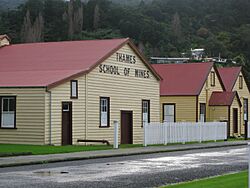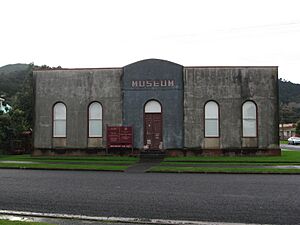Thames School of Mines facts for kids
Quick facts for kids Thames School of Mines |
|
|---|---|
 |
|
| Address | |
|
101 Cochrane St
|
|
| Coordinates | 37°08′06″S 175°32′15″E / 37.1349°S 175.5376°E |
| Information | |
| Opened | 1886 |
| Closed | 1954 |
| Language | English |
The Thames School of Mines was a very important school in Thames, New Zealand, where people learned about mining. It is now a special historic building. Heritage New Zealand lists it as a Category 1 historic place, meaning it's very significant.
Contents
What the School Taught
The Thames School of Mines taught many subjects, mostly about mining. This was stated in their 1901 school plan.
- Mathematics: Important for calculations in mining.
- Mining and Applied Mechanics: How mining works and the machines used.
- Practical Assaying: Testing rocks to find out how much gold or other metals they contained.
- Ventilation and Explosives: How to keep mines safe with fresh air and how to use explosives safely.
The school also helped students get special government certificates. These certificates allowed them to work as:
- Mine Managers
- Battery Superintendents (who ran the machines that processed ore)
- Engine Drivers
- Licensed Assayers
Besides teaching, the school had a collection of rocks and minerals. They also tested rock samples for people. Students and teachers at the school even did experiments to find better ways to get gold out of rocks.
School Buildings and History
The school was built on a special piece of land called an urupa. This land was a resting place for the Ngati Maru Paraone and Te Huiraukura people. The Ngāti Maru tribe originally gave this land for religious purposes. They did not want a primary school there. However, the land was later used for the School of Mines, which opened in 1886.
Over time, other buildings were added to the school complex. These included a church and a Sunday School built in 1869. A mineralogical museum, which displayed rocks and minerals, opened in 1901.
After the School Closed
The Thames School of Mines closed its doors in 1954. In 1979, the New Zealand Historic Places Trust took over the complex. They wanted to protect it because of its history. It is one of only two mining school complexes from the 1800s that still exist in New Zealand.
Today, no universities in New Zealand offer a degree in mining. In 2012, more than 700 people signed a petition at the site. This petition was to help save the Kopu Bridge. Around that time, the school site was also broken into and damaged.
Famous Students
Some notable people who studied at the Thames School of Mines include:
- Charles Arthur Banks: He later became the 17th Lieutenant Governor of British Columbia in Canada from 1946 to 1950.
- Bob Heffron: He became the 30th Premier of New South Wales in Australia from 1959 to 1964.
- John Alexander Agnew: He became the Chairman of a large mining company called Consolidated Gold Fields.
See also
- Reefton School of Mines
- Coromandel Gold Rushes


